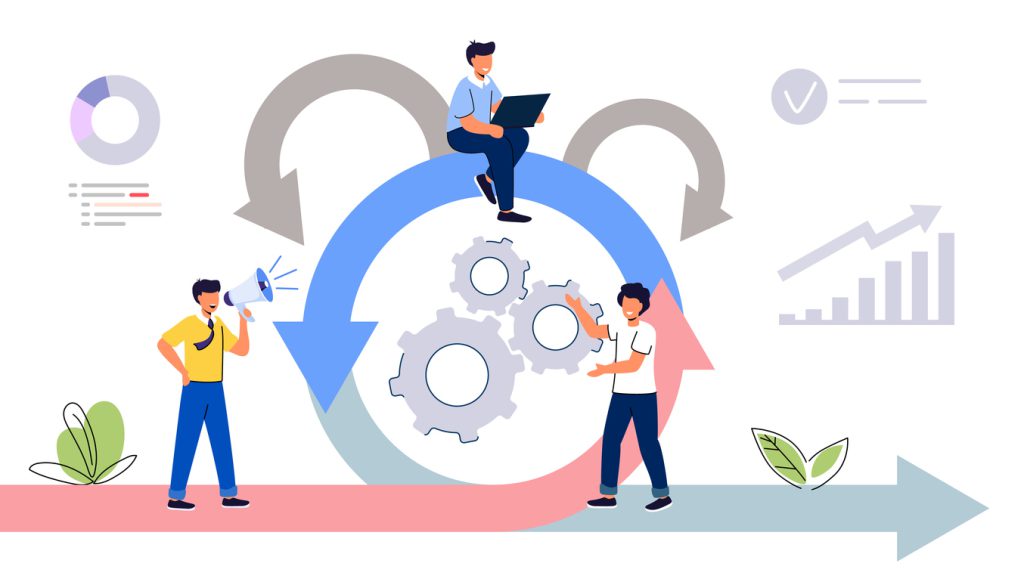Agile Project Management (APM) has become a cornerstone methodology for many successful organizations worldwide, particularly in information technology (IT). Defined by its flexibility, adaptability, and emphasis on iterative progress, Agile is increasingly seen as a significant change in managing projects in today’s dynamic, fast-paced work environment. This article discusses how Agile project management can revolutionize your IT department.
Understanding Agile Project Management
Understanding Agile Project Management (APM) is integral to comprehending the changing dynamics of project execution and team management in various industries, notably IT. APM champions an iterative approach to planning and guiding project processes at its core, departing from traditional project management methodologies that focus on linear, static procedures.
Traditional methodologies often set out a detailed, rigid plan at the beginning of a project and follow it step by step, regardless of changing circumstances. Agile, on the other hand, is more adaptive. It breaks down large, complex projects into small, manageable units or chunks of work. This segmentation facilitates a focus on one aspect of the project at a time, allowing for continuous evaluation, adjustment, and iteration. It provides an environment that welcomes changes and feedback, enabling the project team to respond and adapt quickly, which is crucial in today’s fast-paced, ever-changing business and technological landscape.
The roots of Agile lie in the Agile Manifesto, a seminal document conceived by 17 forward-thinking software developers in 2001. The manifesto laid out twelve key principles centered around enhancing customer satisfaction through delivering valuable software, welcoming changing requirements, frequent delivery of functional software, close collaboration between business stakeholders and developers, and focusing on technical excellence and superior design. The manifesto also stressed the importance of simplicity, self-organizing teams, and regular reflections on becoming more effective.
Over time, these twelve principles have been interpreted and applied in many ways, resulting in different Agile methodologies. Some of these include Scrum, Kanban, and Lean. Each methodology is unique to implementing Agile principles, with different emphases, structures, and practices. Scrum, for example, works exceptionally well for projects with rapidly changing or highly emergent requirements, while Kanban is great for work that requires steady output. Lean, on the other hand, is typically used for optimizing efficiency and minimizing waste.
Agile Project Management is a versatile, responsive, and effective approach to managing projects. It offers a refreshing alternative to traditional methodologies, particularly for industries and projects that benefit from flexibility, collaboration, and iterative progress.
The Old vs. The New: Traditional vs. Agile Project Management
There are several methodologies to choose from in project management, each with its strengths and weaknesses. A comparison of two such methodologies—traditional and Agile project management—reveals stark contrasts, particularly in their approach to project execution and team management.
Traditional project management methodologies follow a linear, phased approach. This strategy, often called the Waterfall model, entails a strict sequence of stages from the project’s conception to its conclusion. The steps typically include initiation, analysis, design, construction, testing, and maintenance. Each phase is completed before moving on to the next, forming a cascading progression similar to a waterfall—hence the name.
While the Waterfall model provides a clear structure and detailed planning, making it suitable for certain projects, it often needs to be revised for IT projects. IT projects typically grapple with rapidly changing requirements, evolving technologies, and the need for quick adaptations. The inflexible nature of the Waterfall model can create inefficiencies as it does not allow for changes or modifications once a stage has been completed.
On the contrary, Agile project management promotes iterative development. Instead of a set sequence, Agile divides projects into short, manageable periods of work called “sprints.” Each sprint aims to deliver a functional part of the project, and the iterative process allows for regular reassessment and adjustment of the project’s direction. This flexibility allows teams to pivot quickly in response to new information or changing requirements. It aligns with IT projects’ unpredictable and dynamic nature, making Agile a more suitable approach in these contexts.
Moreover, Agile promotes a more collaborative and engaged team environment. Frequent communication is a cornerstone of Agile methodologies, with regular check-ins, reviews, and retrospectives incorporated into the process. Feedback is sought, heard, and actioned promptly, fostering a culture of continuous learning and improvement. This dynamic, interactive environment often leads to a more efficient and productive team, as issues are identified and resolved promptly, and team members feel more involved in the project’s success. In contrast to traditional project management’s top-down approach, Agile empowers all team members, promoting a sense of ownership that can drive productivity and innovation.
The transition from traditional to Agile project management signifies a shift from a rigid, linear approach to a flexible, iterative one. It marks a move from individual work silos towards a more collaborative environment, making Agile a compelling choice for IT departments in the fast-paced, ever-evolving technology landscape.
The Transformative Power of Agile in the IT Department
Agile’s focus on flexibility, responsiveness, and collaboration aligns seamlessly with the ever-evolving nature of IT projects. Agile methodologies can dramatically improve productivity by reducing the time wasted planning for “unknown unknowns” and enabling quick responses to changes.
Agile methodologies are designed to optimize productivity by focusing on incremental progress and continuous improvement. The traditional practice of extensive planning to account for all possible scenarios—often referred to as planning for “unknown unknowns”—is mitigated in Agile. Instead, Agile acknowledges the inevitability of change and is designed to react swiftly and effectively when new information arises. This approach minimizes wasted time and resources on excessive planning and instead invests that time in delivering value and responding to changes more adeptly.
Another key transformative aspect of Agile is its emphasis on team collaboration. Agile methods empower team members and propagate the active involvement of all stakeholders in the project. It cultivates a workspace where everyone, from the developers to the customers, has a say in the project, fostering a sense of ownership, responsibility, and engagement among all participants. This inclusive approach often leads to higher productivity, as people work more effectively when they feel their input is valued and their work is impactful.
Many notable businesses, such as IBM and Cisco, have experienced the successful implementation of Agile in their IT departments. These companies provide practical, real-world examples of Agile’s transformative power. Their experiences demonstrate remarkable improvements in several key areas. Productivity enhancements are almost immediate and tangible. However, other less quantifiable but equally important areas like team communication and employee satisfaction also tend to improve. These improvements highlight a more engaged and motivated team, a testament to Agile’s ability to improve work processes and positively influence work culture. Through these case studies, it becomes clear that Agile transformation can usher in a new era of effectiveness and efficiency for IT departments.
Implementing Agile in Your IT Department
Transitioning to Agile requires careful planning and significant cultural change. Ensuring all stakeholders understand Agile principles and are prepared to embrace the change is crucial. Training sessions, workshops, and hiring an Agile coach can facilitate this transition.
Selecting the right Agile methodology is also critical. Teams must choose a methodology that aligns with their work processes and project goals—Scrum, Kanban, or something else.
Several tools can aid Agile project management, from project tracking tools like Jira to communication platforms like Slack. These tools can facilitate real-time collaboration, track progress, manage backlogs, and more.
Overcoming Challenges in Agile Implementation
Despite its benefits, Agile implementation can present its challenges. Resistance to change, lack of upper management support, and ingrained bureaucratic processes can all pose significant obstacles.
Clear and frequent communication is essential to overcome this. It is crucial to convey the benefits of Agile to all stakeholders and address any concerns or misunderstandings.
Moreover, the organization must be prepared for continuous adaptation and improvement. Agile is not a one-size-fits-all solution, and it may take time to find the best approach for your specific team or project.
Measuring the Success of Agile Implementation
Measuring the success of an Agile transformation is only sometimes straightforward, given Agile’s qualitative focus. However, Key Performance Indicators (KPIs) such as lead time, cycle time, team velocity, and customer satisfaction can help quantify Agile’s effectiveness.
Feedback loops—like retrospectives at the end of each sprint—are also vital in measuring success and identifying areas of improvement. Agile is an iterative process, not just in project execution but also in its implementation and continuous improvement.
Conclusions
The potential for Agile to transform the IT department—and, indeed, the entire organization—should not be underestimated. With its emphasis on flexibility, collaboration, and continuous improvement, Agile project management is perfectly equipped to handle IT work’s fast-paced, ever-changing nature.
The journey to Agile may have challenges and require significant cultural shifts. However, the benefits—greater productivity, better collaboration, and improved satisfaction—are worth the effort. As we look towards the future of project management, Agile methodologies are no longer the “new kid on the block”—they’re setting the standard. So, if you’re considering Agile for your IT department, there’s no better time than now.




